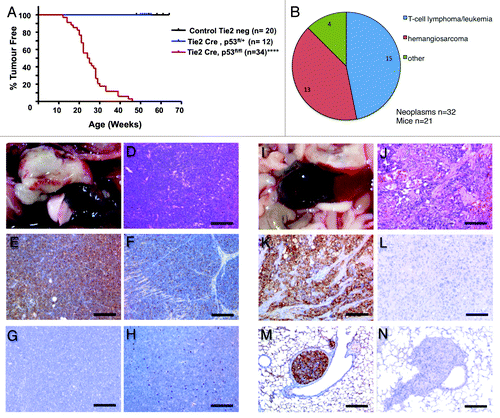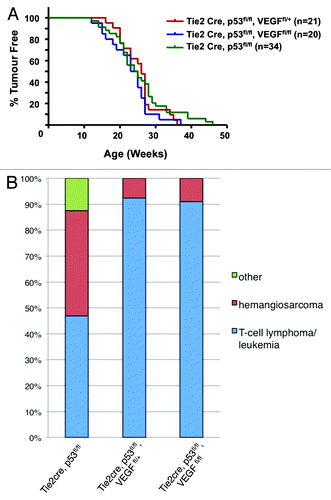Figures & data
Figure 1. Hematopoietic/endothelial deletion of p53 in mice results in T-cell lymphoma/leukemia and hemangiosarcoma development with an average latency of 25 wk. (A) Kaplan–Meier tumor-free survival curve for Cre negative control vs. Tie2-Cre, p53fl/+ and Tie2-Cre, p53fl/fl mice. ***P < 0.0001 (B) Tumor spectrum observed in 21 Tie2-Cre,p53fl/fl mice. Pie chart displaying percentage of T-cell lymphoma/leukemia and hemangiosarcoma observed. (C) Gross presentation of precursor T-cell lymphoblastic lymphoma (PTCLL) arising from the thymus. (D) Microscopically PTCLL consists of dense monomorphic sheets of neoplastic lymphoid cells displaying the typical “starry sky” pattern; H&E stain. (E) Immunohistochemically PTCLL diffusely expresses the T-cell marker CD3. (F) Neoplastic T cells are also variably positive for cKit. (G) PTCLL, negative control for CD3 and cKit immunohistochemistry. (H) Neoplastic lymphocytes are negative for the B-cell marker CD45R/B220. (I) Gross presentation of splenic HSA. (J) Microscopically HSA consists of anaplastic spindle cells lining irregular blood-filled vascular spaces; H&E stain. (K) Immunohistochemically HSA is positive for the endothelial cell marker CD31. (L) HSA, negative control for CD31 immunohistochemistry. (M) CD31-positive emboli of HSA metastasizing to the lung. (N) Metastatic HSA, negative control for CD31 immunohistochemistry. Scale bar for is 100 μm for (J–L) and 200 μm for (D–H, M,and N).

Table 1. Tumor spectrum and frequency in the different cohorts examined
Figure 2. Simultaneous deletion of VEGF and p53 in the hematopoietic/endothelial lineage reduces hemangiosarcoma incidence. (A) Kaplan–Meier tumor-free survival curve for Tie2-Cre, p53fl/+, VEGFfl/fl; Tie2-Cre, p53fl/fl, VEGFfl/+, and Tie2-Cre, p53fl/fl, VEGFfl/fl mice. (B) Bar chart comparing tumor spectrum before and after VEGF deletion. Decrease in hemangiosarcoma development is observed in Tie2-Cre, p53fl/fl, VEGFfl/+ mice (n = 12; P ≤ 0.005) and Tie2-Cre, p53fl/fl, VEGFfl/fl mice (n = 11; P ≤ 0.005) vs. Tie2-Cre, p53fl/fl mice (n = 21).

